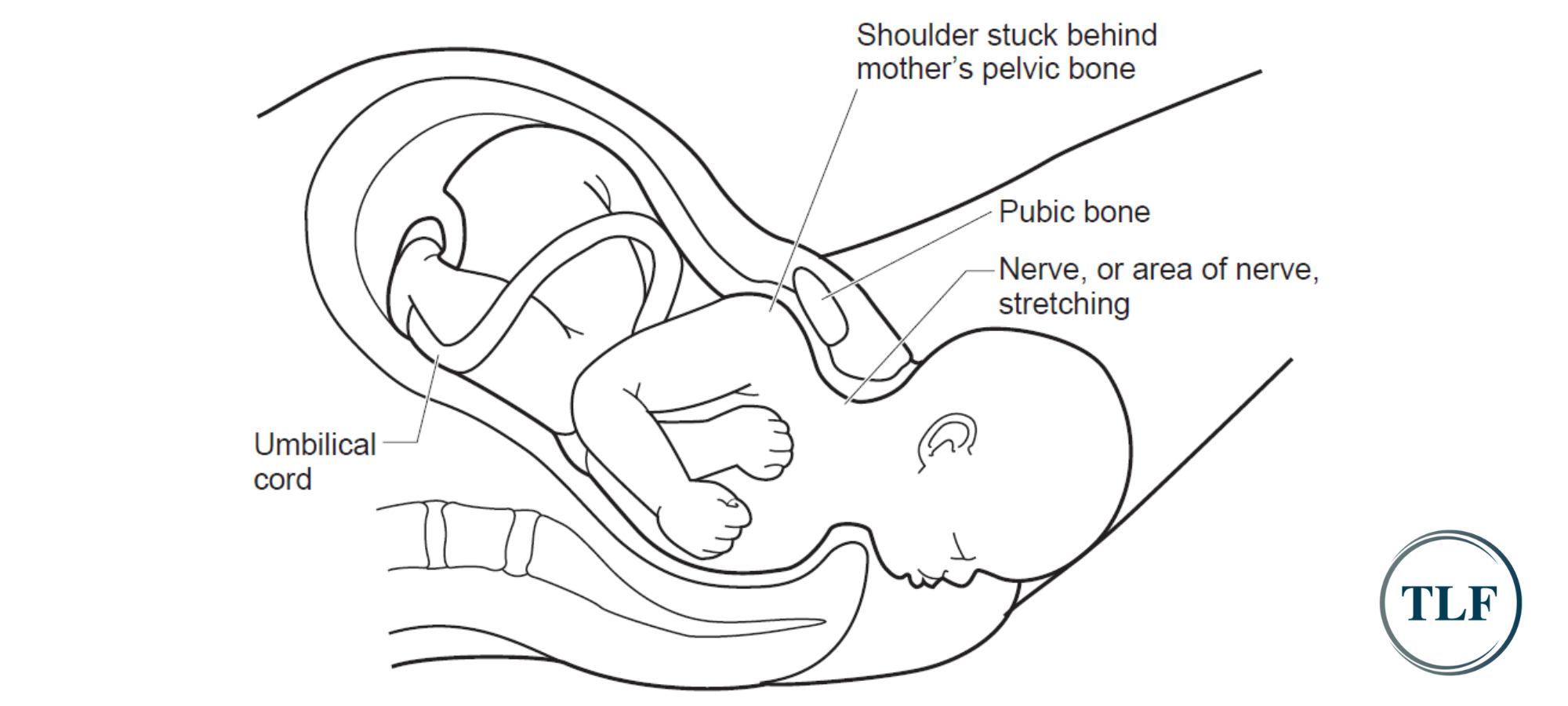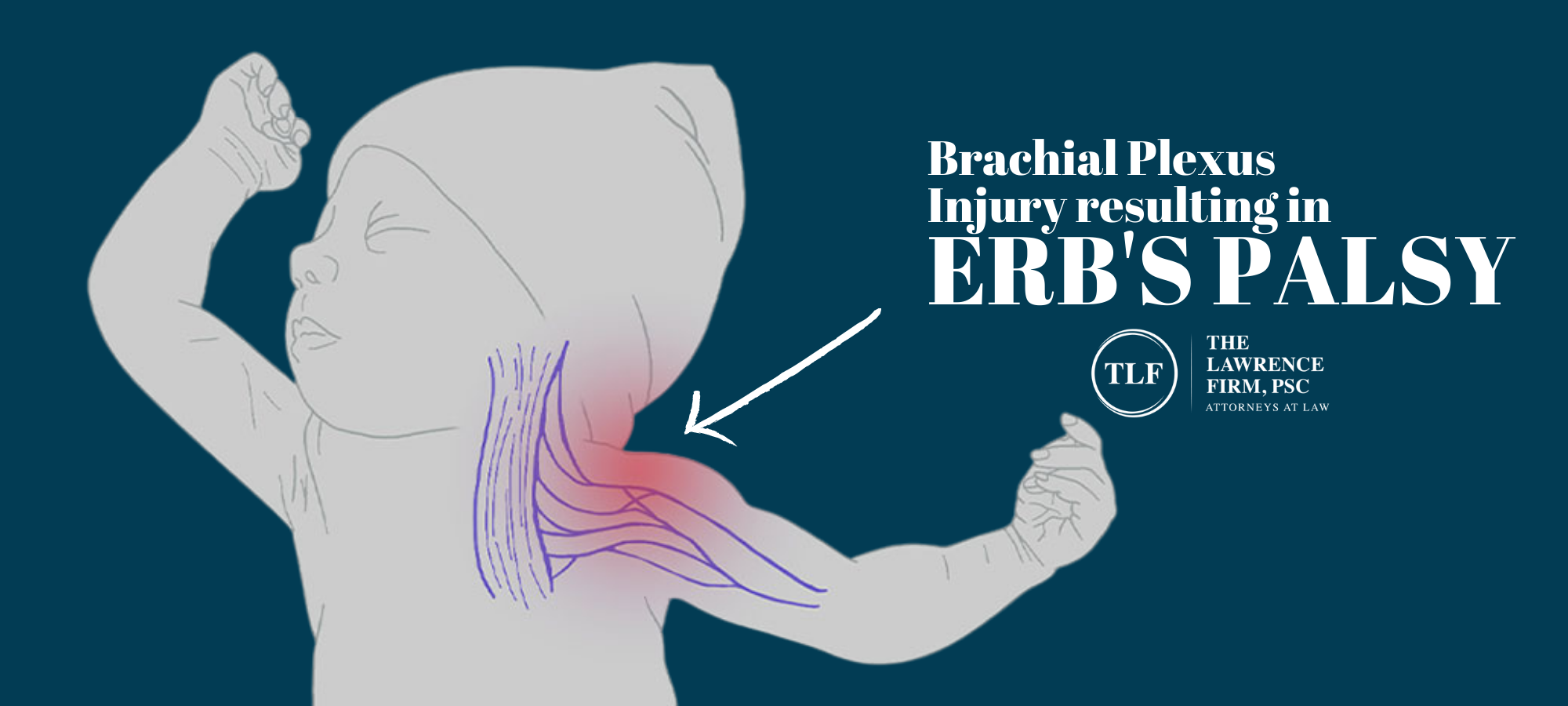Putting Our Knowledge And Experience To Work
Home » Birth Injuries » Shoulder Dystocia
Shoulder Dystocia Birth Injury Lawyer
Experienced Shoulder Dystocia Attorneys in Northern Kentucky and Southwest Ohio
If you or your child has suffered from injuries as a result of shoulder dystocia during birth, contact a shoulder dystocia birth injury lawyer at TLF: The Medical Injury Law Firm today. Mismanaged shoulder dystocia during birth can lead to brachial plexus injuries for the child, which can result in severe, lifelong disabilities.
If a physician applies negligent traction to a baby with shoulder dystocia, then they may be held liable in a birth injury lawsuit. Our Kentucky and Ohio birth injury attorneys at TLF help parents whose babies have suffered as a result of negligent medical care before, during, or after birth. We use our vast experience and legal resources to help obtain compensation for parents and their children for things like medical costs, lost wages, pain and suffering, and more.
With offices in both Covington, KY and Cincinnati, OH, we are proud to provide passionate legal services for clients all throughout the area. Call us toll-free at (800) 698-4054 or reach out online today to schedule a free initial consultation with a shoulder dystocia lawyer on our team.

What is Shoulder Dystocia?
Shoulder dystocia is a childbirth complication where one or both of a baby’s shoulders become lodged behind the mother’s pelvic bone, delaying the delivery and potentially leading to serious health risks for both mother and child.
During a vaginal delivery, the baby’s head and neck should be the first to exit the mother’s womb, followed by the remainder of the body within the next couple of contractions. In shoulder dystocia cases, however, the baby’s shoulders fail to follow the baby’s head through the birth canal during labor and delivery.
This means that, while the head is able to breach the mother’s pubic bone, the infant’s shoulder is essentially stuck behind the pubic bone. As a result, the baby’s shoulders need to be correctly maneuvered by an obstetrician in order to resolve shoulder dystocia. If not, shoulder dystocia can damage the mother and disable the baby.
If your baby suffers from a birth injury such as a brachial plexus injury or Erb’s Palsy because of mismanagement of shoulder dystocia, you may have a medical malpractice claim. Speak with a Covington and Cincinnati birth injury attorney at TLF right away to learn more about your legal rights and options.

How Common is Shoulder Dystocia?
The occurrence rate of shoulder dystocia tends to vary. According to the Cleveland Clinic, shoulder dystocia complications occur in about 0.6% to 1.4% of births in infants weighing between 5 lbs, 8 oz and 8 lbs, 13 oz. However, they report that shoulder dystocia occurs in about 5% to 9% of births in infants weighing more than 8 lbs 13 oz.
Brachial plexus injuries are some of the most common complications arising from shoulder dystocia, with estimates indicating that 1-8 of every 1,000 babies born each year suffer from such injuries.
What are Brachial Plexus Injuries?
Brachial plexus injuries occur when the network of nerves that sends signals from the spine to the shoulder, arm, and hand becomes damaged. These injuries can result in varying degrees of weakness, loss of sensation, or even paralysis in the affected limb.
During a shoulder dystocia delivery, the baby’s shoulder gets stuck behind the mother’s pelvic bone after the infant’s head has been delivered. To free the shoulder, medical professionals might use excessive force or apply improper techniques, potentially stretching or tearing the brachial plexus nerves.
In these cases, the infant might suffer from conditions like Erb’s palsy or Klumpke’s palsy, depending on which part of the brachial plexus is affected. These injuries can lead to long-term functional impairments and may require extensive medical intervention, including physical therapy and surgery, to improve mobility and strength in the affected arm.
Proper and timely medical intervention during delivery can help prevent the infant from suffering from a brachial plexus injury or other severe birth injury.

Dangers of Shoulder Dystocia Birth Injuries
Shoulder dystocia is considered an obstetric emergency. If not controlled and handled promptly by medical professionals, it can result in significant birth injuries to the infant such as Erb’s palsy, cerebral palsy, and other conditions arising from nerve damage. It can also result in broken bones.
Shoulder dystocia is also sometimes associated with umbilical cord issues, such as cord compression. Umbilical cord compression occurs when the umbilical cord is squeezed or pinched during labor and delivery, which can affect the baby’s oxygen supply. In cases of shoulder dystocia, the umbilical cord may be crushed against the mother’s pelvic bone due to the baby’s trapped shoulder. This kind of compression is extremely harmful and can result in serious brain damage.
In very severe and rare cases, failure to properly address shoulder dystocia might also result in the death of a newborn if it is not adequately handled in the delivery room. If surgeons are unable to swiftly remove the baby’s shoulder and deliver the infant, the infant may be deprived of oxygen (birth hypoxia), which can lead to death.
In addition to causing injury to the infant, shoulder dystocia can also cause major problems for the mother. Postpartum hemorrhage is the most prevalent maternal health issue connected with shoulder dystocia. In some shoulder dystocia cases, the mother may suffer from cervical or vaginal lacerations, as well as serious injury to the rectum and bladder.
Risk Factors for Shoulder Dystocia
In general, shoulder dystocia is not something that can be predicted and can occur in virtually any pregnancy. However, there are certain factors that might make a baby more susceptible to shoulder dystocia. The leading risk for shoulder dystocia is a large baby with a high birth weight.
A baby weighing more than 8 pounds, 13 ounces at birth is more likely to suffer from shoulder dystocia than babies born under that weight. Other potential risk factors include things like:
- Short maternal stature
- Overdue pregnancy
- Maternal obesity
- Maternal diabetes / gestational diabetes
- Platypelloid (flat) pelvis
- Maternal weight gain (excessive weight gain of over 35 lbs)
- Abnormally long labor
- Shoulder dystocia in previous pregnancy
- Having multiple babies at once

Shoulder Dystocia Long-Term Effects
A serious shoulder dystocia injury can have life-altering and long-term effects on a newborn and their family. Injuries from shoulder dystocia occur when medical professionals attempt to pull the baby out without attempting standard obstetric maneuvers that have been proven to work for shoulder dystocia.
Sometimes, these unwarranted maneuvers may stretch and break the nerves in the baby’s neck and shoulder, resulting in limb paralysis, cerebral palsy, Erb’s palsy, and other serious birth injuries and complications. Additionally, the use of excessive force can lead to bone fractures, nerve injury, or hypoxia, which occurs when blood flow to the infant’s brain is reduced, preventing the brain from receiving adequate oxygen.
As a result of this medical malpractice, the infant may experience medical problems and permanent injury for the rest of their lives – or worse. Babies often need orthopedic or neurosurgery in the first months of life to correct problems caused by poor management of shoulder dystocia. From there, they may still require years of medical treatment, therapy, and the use of assistive devices for the remainder of their life.
To ensure their child’s comfort, parents often go to great lengths and spend an excessive amount of their own money. This simply should not be the case if a medical professional is at fault for the birth injury in question. If a doctor’s error can lead to a lifetime of troubles and challenges, they should be held financially responsible for these troubles.
If you or your child have suffered long-term effects from birth injuries of any kind that resulted from medical malpractice, you have the ability to file a birth injury lawsuit against the responsible parties. At TLF, our shoulder dystocia lawyers can help fight on behalf of you and your child to ensure you recover compensation for your losses.
Can You Prevent Baby Shoulder Dystocia?
Though there is generally no way to prevent shoulder dystocia from occurring, there are actions that a doctor should take to lessen the chance of any further injury. For example, proper screening and monitoring can help medical professionals identify the warning signs of shoulder dystocia.
From there, medical personnel can prepare for the risk of shoulder dystocia and apply established medical techniques to help avoid any potential problems. These techniques include repositioning the woman or the infant to allow the shoulder to pass through the birth canal – like the McRoberts maneuver – or applying suprapubic pressure to the mother’s body.
In a serious medical emergency, doctors can turn to other interventions like a very deep episiotomy, breaking the baby’s collarbone or the mother’s pelvis, or performing an emergency C-section. These can help reduce the risk of serious birth injury caused by shoulder dystocia, like birth asphyxia or fetal death.

Medical Malpractice Claim for Shoulder Dystocia
All doctors and nurses owe obligations to the patients they serve. During labor and delivery, the delivery team must keep an eye on both the baby and the mother to spot any potential difficulties and anticipate complications like shoulder dystocia, among other potential birth injuries.
Failure to follow acknowledged standards of care throughout pregnancy, labor, and delivery can result in serious birth injury, disability, and even death for the infant, mother, or both. If a doctor or other healthcare provider fails to monitor or respond appropriately to shoulder dystocia during delivery, they may be considered negligent in their obligation to their patient.
To be negligent as a result of a medical error made during pregnancy or childbirth, the medical professional must not have employed the same level of care as other members of the medical profession in the same or comparable situations. This is the basis for a medical malpractice lawsuit.
Medical malpractice in shoulder dystocia claims can come in various forms, including a failure to monitor, a failure to perform an emergency C-section, or a failure to use other obstetric maneuvers to prevent injury. Our birth injury attorneys at TLF can help you and your family understand your legal options following your child’s shoulder dystocia injury.
Potential Compensation in a Shoulder Dystocia Medical Malpractice Claim
If you or your child suffered from injuries as a result of a shoulder dystocia injury, you may be able to recover compensation for various damages, depending on the actual damages you suffered as a result of the injury or injuries. Some common forms of compensation available in shoulder dystocia lawsuits include:
- Medical bills
- Lost wages
- Pain and suffering
- Emotional distress
- Loss of earning potential
- Permanent disability
- Assistive technology costs
- Funeral and burial expenses, in the event of a wrongful death
A medical negligence attorney can help evaluate your damages and determine how much compensation you may be entitled to in an Ohio or Kentucky shoulder dystocia claim.
Shoulder Dystocia Death Claims
In some shoulder dystocia cases, the infant’s injuries are so severe that they result in fetal death, which can be devastating for the mother and the rest of the infant’s family. In this case, the parents of the deceased child can file a wrongful death claim against the negligent medical professionals responsible for the child’s death.
In wrongful death lawsuits, it’s important to prove that the infant’s death was the direct result of wrongful or negligent medical treatment. An experienced shoulder dystocia birth injury lawyer will be able to investigate the situation surrounding the child’s death, gather evidence, and prove negligence on behalf of the medical staff responsible.

Do You Have Shoulder Dystocia Medical Malpractice Lawsuit?
If the doctor or delivery team’s negligence contributed to you or your child’s birth injury or death, then you may have a shoulder dystocia medical malpractice lawsuit. At TLF: The Medical Injury Law Firm, our birth injury lawyers have plenty of experience examining medical errors and birth injury malpractice cases in Kentucky and Ohio, as well as the means to obtain outside experts who can analyze intricate birth injury cases, if necessary.
Some shoulder dystocia injuries can be traced back to the carelessness of physicians, nurses, and other medical staff. However, this can only be proven through a thorough examination of the medical records on the incident, as well as eyewitness and expert testimony.
When your child’s preventable shoulder dystocia or related birth injury has caused you and your family suffering, you may be able to file a claim for medical negligence and receive proper compensation for your losses. Call our medical malpractice attorneys at TLF today to learn more about the potential of your case.
Call the Covington and Cincinnati Birth Injury Attorneys at TLF Today for a FREE Consultation
If your baby’s injuries were the result of mismanagement of shoulder dystocia, contact our experienced Ohio and Kentucky birth injury attorneys at TLF today to discuss your potential shoulder dystocia case.
Call TLF: The Medical Injury Law Firm toll-free at (800) 698-4054 or complete our online intake form for a free consultation to discuss your options. You can also call our Ohio law office at (513) 651-4130 or our Kentucky law office directly at (859) 578-9130.
Practice Areas
You Pay No Fees Unless We Win!
We are happy to offer a free consultation to evaluate your case. If you hire us as your legal counsel, we will represent you on a contingency-fee basis. You will pay no attorneys’ fees unless we recover financial damages.
